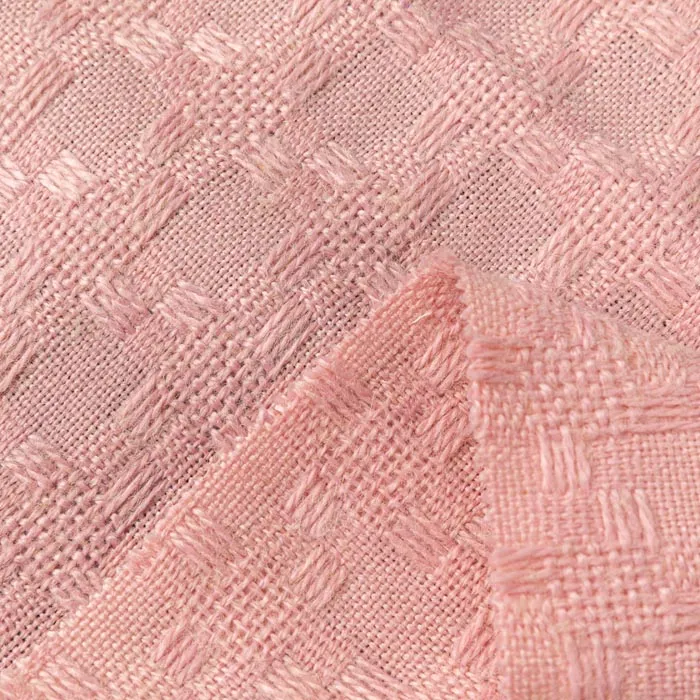 English
English Español
Español  Português
Português  русский
русский  Français
Français  日本語
日本語  Deutsch
Deutsch  tiếng Việt
tiếng Việt  Italiano
Italiano  Nederlands
Nederlands  ภาษาไทย
ภาษาไทย  Polski
Polski  한국어
한국어  Svenska
Svenska  magyar
magyar  Malay
Malay  বাংলা ভাষার
বাংলা ভাষার  Dansk
Dansk  Suomi
Suomi  हिन्दी
हिन्दी  Pilipino
Pilipino  Türkçe
Türkçe  Gaeilge
Gaeilge  العربية
العربية  Indonesia
Indonesia  Norsk
Norsk  تمل
تمل  český
český  ελληνικά
ελληνικά  український
український  Javanese
Javanese  فارسی
فارسی  தமிழ்
தமிழ்  తెలుగు
తెలుగు  नेपाली
नेपाली  Burmese
Burmese  български
български  ລາວ
ລາວ  Latine
Latine  Қазақша
Қазақша  Euskal
Euskal  Azərbaycan
Azərbaycan  Slovenský jazyk
Slovenský jazyk  Македонски
Македонски  Lietuvos
Lietuvos  Eesti Keel
Eesti Keel  Română
Română  Slovenski
Slovenski  मराठी
मराठी  Srpski језик
Srpski језик
What Techniques Are Used with Fine Fabrics in Couture?
2024-10-14
Couture, the pinnacle of high fashion, is synonymous with precision, artistry, and the meticulous handcrafting of garments using the most luxurious materials available. In the world of couture, working with fine fabrics such as silk, chiffon, lace, and velvet requires a special set of skills and techniques to ensure that the final garment is not only beautiful but also well-constructed and long-lasting. Each fabric brings its own challenges, and couture techniques are designed to work harmoniously with these delicate materials. In this blog, we’ll explore the essential techniques used by couturiers to handle fine fabrics and bring stunning designs to life.

1. Hand Sewing and Finishing Techniques
One of the most distinctive features of couture is the use of hand sewing. While machine stitching may be employed for basic seams, the finer details and finishing touches are typically done by hand. This allows for precision and control, particularly with delicate fabrics that can easily be damaged by machines.
- Hand basting: Before the final stitching, couturiers often hand-baste seams to ensure the fabric is positioned correctly. This temporary stitching holds the fabric in place and prevents shifting, which is especially important when working with slippery materials like silk or satin.
- Hand-rolled hems: For fabrics like chiffon or organza, a hand-rolled hem is often used. This technique creates an almost invisible edge finish by carefully rolling the fabric’s edge and securing it with small, tight stitches.
- Invisible hems: Couture garments often require an invisible hem finish to maintain a clean, seamless look. This technique involves sewing by hand with tiny stitches that barely catch the fabric, creating a smooth hem that is virtually undetectable on the outside.
2. Couture Draping
Draping is a foundational technique in couture, allowing designers to sculpt fabric directly on a dress form, ensuring a perfect fit and flow. When working with fine fabrics, draping allows the couturier to see how the fabric behaves when it falls and moves, ensuring the design flatters the body and captures the fabric’s natural beauty.
- Bias-cut draping: In couture, cutting fabric on the bias (diagonally to the grain) allows for greater stretch and a more fluid drape. This is particularly effective with fine fabrics like silk or satin, which benefit from the enhanced movement and elegant flow created by bias cutting.
- Pinning and folding: During the draping process, fabrics are carefully pinned and folded to create soft pleats, gathers, or ruching. Delicate handling is essential when working with fine materials, as too much tension can cause the fabric to stretch or tear.
3. Underlining and Interfacing
Fine fabrics often require additional support to maintain structure, shape, and durability. Underlining and interfacing are key techniques used in couture to provide stability without compromising the fabric's delicate quality.
- Underlining: This involves sewing a second layer of fabric to the main fabric to give it more body or to prevent sheer materials from being see-through. Silk organza is commonly used as an underlining for fine fabrics like lace or chiffon because it adds strength without adding weight or bulk.
- Interfacing: For areas that require extra firmness, such as collars, cuffs, or waistlines, interfacing is applied. In couture, this is often done with lightweight, hand-sewn interfacing, which gives subtle structure without the stiffness of machine-fused versions.
4. Seam Finishing Techniques
The seams in couture garments are meticulously finished to prevent fraying, maintain durability, and ensure a polished look both inside and out. For fine fabrics, these finishes need to be gentle and invisible.
- French seams: This seam finish is perfect for delicate fabrics like chiffon or silk. It encloses the raw edges of the fabric within the seam itself, creating a clean, fray-resistant edge that looks impeccable on both sides of the garment.
- Hand overcasting: Instead of using a machine, hand overcasting is used in couture to finish seams on fine fabrics. This method involves stitching along the edges of the fabric to prevent fraying without the bulkiness or visibility of serged edges.
- Hong Kong seams: This technique involves binding the raw edges of the fabric with a lightweight bias tape, which is ideal for materials like satin or velvet. It creates a clean, refined finish that adds a decorative element inside the garment while protecting the edges.
5. Appliqué and Embellishments
Many couture designs incorporate intricate appliqué work and embellishments, such as beads, sequins, or embroidery. Working with fine fabrics requires specialized techniques to ensure these decorative elements are securely attached without damaging the material.
- Hand-stitched appliqué: Instead of machine stitching, appliqué is often applied by hand to maintain control and precision. Delicate fabrics like lace or tulle benefit from hand appliqué, where intricate shapes can be sewn on with invisible or decorative stitches.
- Embellishment placement: When adding beads or sequins to fine fabrics, care must be taken to distribute the weight evenly. Couturiers use small, hand-sewn stitches to secure each bead or sequin individually, ensuring that the fabric isn’t stressed or pulled in any direction. Beading is often done on underlined sections to add more support.
- Embroidery on tulle or organza: When embellishing fragile fabrics like tulle or organza, couture houses often use a special frame or hoop to keep the fabric taut. This prevents puckering or tearing as the embroidery is applied.
6. Lining and Layering
Fine fabrics often need to be lined or layered to create depth, texture, or coverage. Lining adds both function and luxury, providing additional comfort for the wearer while enhancing the drape of the garment.
- Silk linings: Many couture garments made from delicate fabrics are lined with lightweight silk, such as silk habotai or charmeuse. The lining not only feels luxurious against the skin but also adds opacity and structure to garments made from sheer fabrics like lace or tulle.
- Layering for volume: To achieve the dramatic volume often seen in couture gowns, layers of fine fabrics like tulle, organza, or chiffon are carefully built up. These layers are often hand-sewn to maintain control over the garment’s shape and movement.
7. Pressing and Steaming
Pressing is a critical step in the couture process and requires special attention when working with fine fabrics. Incorrect pressing techniques can ruin delicate materials, leaving permanent marks or causing fabric distortion.
- Low heat and pressing cloths: For fabrics like silk or satin, it’s important to use low heat and always place a pressing cloth between the iron and the fabric to avoid scorching or shining. Couturiers often use steam to gently remove wrinkles without putting direct pressure on the fabric.
- Shaping with steam: For fabrics that require shaping, such as silk or wool crepe, steam can be used to mold the fabric gently. Careful manipulation of heat and moisture allows the couturier to shape the fabric to the body without damaging its structure.
The art of couture lies in the marriage of luxurious fine fabrics with time-honored techniques that ensure both beauty and durability. Each technique—from hand sewing and draping to finishing seams and applying embellishments—requires precision and expertise to handle the unique challenges posed by delicate materials. When executed correctly, these techniques result in garments that are both visually stunning and meticulously crafted, embodying the very essence of couture craftsmanship.
Zhejiang Jufei Textile Co., Ltd. has been focusing on the field of polyester woolen fabric. After more than 10 years of development and growth in polyester woolen fabric industry, we have developed from domestic company named Shaoxing Ruifeng Textile Co.to now facing the international market which is a scientific, industrial and trade enterprise integrating development, production, sales and trade. Our main products are: woolen fabric, knitting fabric, woven fabric, polyerster woolen fabric, knitted woolen fabric, artificial wool fabric. Explore our full range of products on our website at https://www.jufeitextile.com. For any inquiries, please reach out to us at ruifengtextile@126.com.
-
E-mail
-
Call Us
-
Address
Guancheng International Keqiao Shaoxing, Zhejiang, China
If you have any enquiry about quotation or cooperation, please feel free to email or use the following inquiry form. Our sales representative will contact you within 24 hours.
Copyright © 2022 Zhejiang Jufei Textile Co., Ltd.- Woolen Fabric, Knitting Fabric, Woven Fabric -All Rights reserved.





